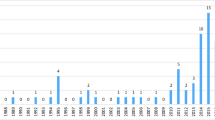Abstract
Time/flow is a decisive variable when proposing public health interventions in jail populations and settings. The present paper argues that jail flow affects the types of public health interventions achievable in ways not acknowledged generally by public health/medical researchers. The paper explores how public health interventions vary among jail populations in terms of “flow” and how they are affected by a “period” effect. Interventions that will be effective and reach a substantial portion of the jail population are dependent upon the point in the jail processing process. In turn, the variables that affect the speed of population flow through the jail setting also influence who will be served by public health interventions.
Similar content being viewed by others
References
Bandyopadhyay, T., Murray, H., & Metersky, M. L. (2002). Cost-effectiveness of tuberculosis prophylaxis after release from short-term correctional facilities. Chest, 121(6), 1771.
Bell v. Wolfish, 441 520 (Supreme Court 1979).
CDC. (2006). Prevention and control of tuberculosis in correctional and detention facilities: Recommendations from CDC. Retrieved. from http://www.cdc.gov/mmwr/PDF/rr/rr5509.pdf.
Cohen, T. H., & Reaves, B. (2007). Pretrial release of felony defendants in state courts. Retrieved. from http://www.ojp.usdoj.gov/bjs/pub/pdf/prfdsc.pdf.
Gregg, M. B. (2002). Field epidemiology. USA: Oxford University Press.
Greifinger, R. B. (2007). Thirty years since Estelle v. Gamble: Looking forward, not wayward. In R. B. Greifinger, J. Bick, & J. Goldenson (Eds.), Public health behind bars: From prisons to communities (pp. 1–10). Dobbs Ferry: Springer.
Kahn, R. H., Scholl, D. T., Mpvm, P. D., Shane, S. M., Lemoine, A. L., & Farley, T. A. (2002). Screening for syphilis in arrestees: usefulness for community-wide syphilis surveillance and control. Sexually Transmitted Diseases, 29(3), 150.
Kim, S., & Crittenden, K. (2007). Treatment completion among TB patients returned to the community from a large urban jail. Journal of Community Health, 32(2), 135–147.
Kraut-Becher, J. R., Gift, T. L., Haddix, A. C., Irwin, K. L., & Greifinger, R. B. (2004). Cost-effectiveness of universal screening for chlamydia and gonorrhea in US jails. Journal of Urban Health, 81(3), 453–471.
MacGowan, R., Margolis, A., Richardson-Moore, A., Wang, T., Lalota, M., French, P. T., et al. (2009). Voluntary rapid human immunodeficiency virus (HIV) testing in jails. Sexually Transmitted Diseases, 36(2), S9.
Maruschak, L., Sabol, W., Potter, R. H., Reid, L. C., & Cramer, E. W. (2009). Pandemic influenza and jail facilities and populations. American Journal of Public Health, 99(S2), S339–S344.
Potter, R. H. (2010). Jails, public health, and generalizability. Journal of Correctional Health Care, 16, 263–272.
Potter, R. H., & Akers, T. A. (2010). Improving the health of minority communities through probation-public health collaborations: An application of the epidemiological criminology framework. Journal of Offender Rehabilitation, 49(8), 595–609.
Potter, R. H., Lin, H., Maze, A., & Bjoring, D. (Forthcoming, 2011). The Health of jail inmates: The role of jail population “flow” in community health.
Ramaswamy, M., & Freudenberg, N. (2007). Health promotion in jails and prisons: An alternative paradigm for correctional health services. In R. B. Greifinger, J. Bick, & J. Goldenson (Eds.), Public health behind bars (pp. 229–248). Dobbs Ferry: Springer.
Spaulding, A. C., Clarke, J. G., Jongco, A. M., & Flanigan, T. P. (2009). Small reservoirs: Jail screening for gonorrhea and chlamydia in low prevalence areas. Journal of Correctional Health Care, 15(1), 28.
Spaulding, A. C., Seals, R. M., Page, M. J., Brzozowski, A. K., Rhodes, W., & Hammett, T. M. (2009). HIV/AIDS among inmates of and releasees from US Correctional Facilities, 2006: Declining share of epidemic but persistent public health opportunity.
Author information
Authors and Affiliations
Corresponding author
Rights and permissions
About this article
Cite this article
Potter, R.H., Lin, H., Maze, A. et al. Jails and Public Health Service Delivery and Empirical Knowledge: The Impact of Jail Population “Flow”. Am J Crim Just 37, 200–208 (2012). https://doi.org/10.1007/s12103-011-9116-4
Received:
Accepted:
Published:
Issue Date:
DOI: https://doi.org/10.1007/s12103-011-9116-4




